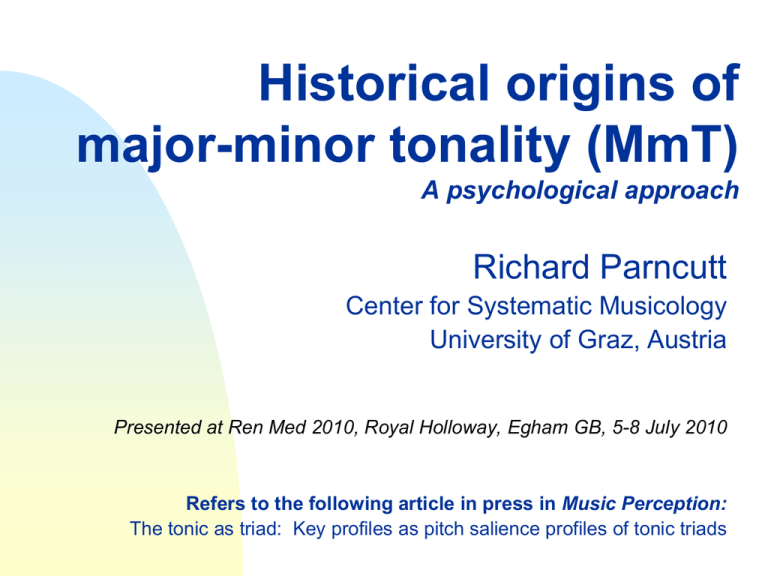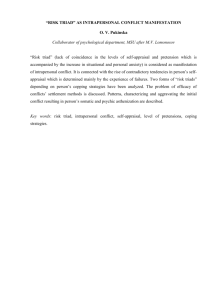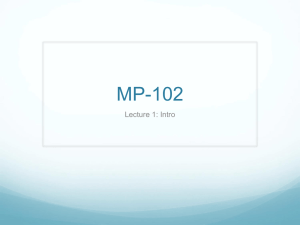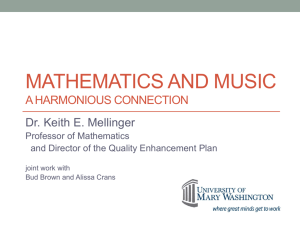Document
advertisement

Historical origins of major-minor tonality (MmT) A psychological approach Richard Parncutt Center for Systematic Musicology University of Graz, Austria Presented at Ren Med 2010, Royal Holloway, Egham GB, 5-8 July 2010 Refers to the following article in press in Music Perception: The tonic as triad: Key profiles as pitch salience profiles of tonic triads Explaining MmT’s hegemony Like it or lump it... most music heard today is based on major & minor triads major & minor keys Why? In the “West” polyphony, ficta, triads? Beyond the “West” political? psychological? Explaining musical structure the “Why is the sky blue?” approach MmT: Why is it like it is? And not quite different? (Eberlein, 1994) Early music: Why did certain structures and patterns emerge in one century and disappear again in another? Eberlein, R. (1994). Die Entstehung der tonalen Klangsyntax. Frankfurt: Peter Lang. History of tonal syntax: Processes Perceptual universals History of ideas Stylistic or compositional norms (statistical regularities) Music perception (expectations) Rules of composition Music ficta and MmT’s “emergence” a theory focusing on notation Mixolydian major, Dorian minor, usw. Musica ficta can explain the scale steps in major/minor keys. But it cannot explain their relative stability Epistemology and approach Favor simpler theories (Ockam) details are important (Dahlhaus) but simpler theories are easier to falsify (Popper) Favor generative theories (Lerdahl) identify underlying principles or axioms non-circular arguments, causeeffect Favor interdisciplinarity (CIM, JIMS) relevant knowledge should be considered multidisciplinary theories are easier to falsify History of triads “pretonal” “emergence” of MmT 12th 13th 2-part counterpoint, discant improvisation 3- and 4-part ctpt, 3rds & 6ths, imperfect consonances 14th 15th Cent 16th Cent 17th Cent Ars Nova (Vitry, Machaut) double-leading-tone cadence Dunstable, Dufay, Ockeghem falling fifth cadence in 3 and 4 parts Fauxbourdon: parallel 6/3 triads Falsobordone: chains of root positions Palestrina, Lassus most sonorities are major and minor triads final fifth replaced by triad; tierce de Picardie all final sonorities become triads seventh chords, clear SDT progressions Historical emergence of triads an educated guess proportion (%) 100 thirds triads final triads 0 1000 1200 1400 year 1600 1800 Causal relation between the three lines? History of triadic theory Century Idea 14th lowest voice governs sonority 15th triad as intervals Theorists Tewkesbury (mid 14th), other contrapunctus tracts Tinctoris (1477), Podio (1495), Gafori (1496) 16th triad as sonority Zarlino (1558), Sancta Maria (1565), Avianus (1581) 17th root and inversion Burmeister 1606), Harnisch (1608), Lippius (1612), Campion (1618), Crüger (1630) 18th implied roots Rameau (1721) Karl Popper’s “three worlds” and Medieval music perception World 1: physical, material World 2: experience, subjectivity World 3: knowledge, information We need to clearly separate… 1. 2. 3. physics: measured frequencies, durations experience: perceived pitches, durations notation: symbolic pitches and durations Emergence of Mm triads & tonalities in “Popperian cosmology” World 1 World 2 World 3 (physics) (experience) (knowledge) Familiarity Conceptualization Represen- Performance tation (notation) Period 14th-16th C. (tonal cognition) (verbal cognition) 15th-17th C. 16th-18th C. Causal chain: Each stage is a pre- or co-requisite for the next What is special about Mm triads? Frequency ratios? major: 4:5:6 seems ok minor: 10:12:15 is not so “simple” Is tuning pure or Pythagorean? Harmonic dualism? overtones exist undertones do not root of C minor is C not G Psychoacoustics of consonance 3 well established psychological factors Roughness (Helmholtz) nearby partials on basilar membrane peripheral physiology Fusion (Stumpf) holistic perception of complex sounds neural processing Familiarity (Cazden, Tenney) exposure promotes liking neural processing pc-set theory and consonance: 19 Tn-types of cardinality 3 after Rahn (1980) prime form 012 013 014 015 016 024 025 026 027 036 037 048 023 034 045 056 035 046 047 inversion 012 = e.g. C-C#-D 013 = e.g. C-C#-D# 037 = minor triad 047 = major triad The major and minor triads are by far the most consonant Tn-types of cardinality 3. Only they have a P4 or P5 (fusion) and no M2 or m2 (roughness). Why is ear training so difficult? We do not hear frequencies (World 1), notes (World 3) We hear pitches (World 2) and extrapolate to notes by musical experience theoretic knowledge What about missing fundamentals? e.g. voice on telephone Mm triads have missing fundamentals at 2nd, 4th and 6th above root Missing fundamentals of a major triad missing fundamentals some higher harmonics notes harmonics (up to C7) C4 C5 G5 C6 E6 G6 Bb6 C7 A3 E6 G6 A6 B6 6 7 8 9 E4 E5 B5 E6 G#6 B6 F3 C6 F6 G6 A6 6 8 9 10 G3 G4 D5 G5 B5 D6 F6 G6 A6 B6 D3 C6 D6 E6 A6 7 8 9 12 Missing fundamentals of a minor triad missing fundamentals higher harmonics notes harmonics (up to C7) C4 C5 G5 C6 E6 G6 Bb6 C7 F3 C6 Eb6 F6 G6 A6 6 7 8 9 10 Eb4 Eb5 Bb5 Eb6 G6 Bb6 Ab3 C6 Eb6 Bb6 5 6 9 G3 G4 D5 G5 B5 D6 F6 G6 A6 B6 D3 C6 D6 E6 A6 7 8 9 12 Missing fundamentals of a major triad octave generalized model – assuming octave equivalence notes harmonics missing fundamentals C C G E Bb D A E G (B) E E B G# D F# F C G (A) G GDBFA D C E (A F#) harmonics Missing fundamentals of a minor triad octave generalized model – assuming octave equivalence notes harmonics missing fundamentals C C G E Bb D F C Eb G (A) Eb Eb Bb G Db F Ab C Eb (Bb) G GDBFA D C (D A E) harmonics Experiment on pitch salience in musical chords major triad 047 minor triad 037 3 goodness of fit 3 2 1 0 -1 0 1 2 3 4 5 6 7 8 pc 9 10 11 12 2 1 0 -1 0 1 2 3 4 5 6 7 8 9 10 11 12 pc Parncutt, R. (1993). Pitch properties of chords of octave-spaced tones. Contemporary Music Review, 9, 35-50. Krumhansl, C. L., & Kessler, E. J. (1982). Tracing the dynamic changes in perceived tonal organization in a spatial representation of musical keys. Psychological Review Krumhansl’s key profiles pc-stability profiles Prevalence model of key profiles major key minor key Aarden, B. (2003). Dynamic melodic expectancy. PhD dissertation, Ohio State University. Why is G more prevalent that C in C major - but C is more stable? Lerdahl’s “basic pitch space” for the key of C major – after Deutsch & Feroe level a level b C C level c level d C C level e C Db D Eb E F F# G Ab A Bb B hierarchical depth 5 1 2 1 3 2 1 4 1 2 1 2 G D E E F G G A B Lerdahl, E. (2001). Tonal pitch space (p. 47). New York: Oxford. Deutsch, D., & Feroe, J. (1981) The internal representation of pitch sequences in tonal music. Psychological Review, 88, 503-522. Open triangles: pc stability profile of MmT1 Full squares: pc salience profile of tonic triad2 (a) C major (b) C minor 7 K&K82 7 pc-weight/3 (Pmo88) average rating (K&K82) Pmo88 5 5 3 3 1 1 C D E F G A B -1 C D E F G A B 12 chroma 1Krumhansl, C. L., & Kessler, E. J. (1982). Tracing the dynamic changes in perceived tonal organization in a spatial representation of musical keys. Psychological Review 2Parncutt, R. (1988). Revision of Terhardt's psychoacoustical model of the root(s) of a musical chord. Music Perception Prevalence of pitches in Gregorian chant 350 initial tone prevalence 300 final tone 250 any tone /10 200 150 100 50 0 0 1 2 3 4 5 6 7 8 9 10 11 chroma (semitones above C) B (11) is the least frequent tone at any position. Source of data: Bryden, J. R., & Hughes, D. G. (1969). An index of Gregorian chant. Cambridge, MA: Harvard University Press.). Chant: Why are some pitches more common than others? Theory: Tones whose harmonics correspond to diatonic scale steps are more consonant preferred more prevalent Implication for mi-fa: fa is more common more stable origin of leading tone? What is a music psychologist doing at MedRen? Long-term project: history of tonal syntax and perception humanities: music history, music theory sciences: psychology, computing Planned first step: ESF strategic workshop 15-30 speakers, many European countries 1-3 days, plenty of discussion follow-up research project *ESF = European Science Foundation (“science” = “Wissenschaft”?) Double leading-tone cadence prevalence of cadence and contexts in different periods? Origin: two-part cadences (12th Century) major sixth octave; major third fifth; etc. double-leading-tone cadence (14th) two intervallic resolutions simultaneously falling-fifth cadence (16th) transition from 3 to 4 voices voicing GDGB-CCGC avoids parallels Triads in Palestrina: Canticum Canticorum (1583-84), Motet 1 root major C 14+3+1=18 minor 4+7+1=12 sus 1+0+0=1 dim 0+0+0=0 total 19+10+2=31 D 6+4+0=10 18+5+3=26 8+1+0=9 0+0+0=0 32+10+3=45 Eb 2+3+0=5 0+0+0=0 0+0+0=0 0+0+0=0 2+3+0=5 E 0+0+0=0 1+0+0=1 0+0+0=0 2+0+0=2 3+0+0=3 F 30+5+0=35 0+0+0=0 1+0+0=1 0+0+0=0 31+5+0=36 G 17+1+0=18 28+8+1=37 2+0+0=2 0+0+0=0 47+9+1=57 A 5+2+0=7 4+1+0=5 3+0+0=3 0+0+0=0 12+3+0=15 Bb 29+6+0=35 0+0+0=0 1+0+0=1 0+0+0=0 30+6+0=36 tot 103+24+1=128 55+21+5=81 16+1+0=17 2+0+0=2 each cell: Root position + first inversion + second inversion = total Sonorities in Renaissance polyphony Hierarchy of chord types: • major triad • minor triad • suspended triad • diminished triad Hierarchy of chord positions: • root position • first inversion • second inversion Psychological theory • guiding principle is consonance • hierarchy of psychoacoustic components: • fusion (brain; perception of complex tones) • smoothness (inner ear; frequency analysis) Triads in Palestrina: Canticum Canticorum (1583-84), Motet 1 number of occurrences 30 25 20 15 10 5 0 -5 -4 -3 -2 -1 0 1 2 3 4 5 Interval between successive roots (semitones) Eberlein, R. (1994). Die Entstehung der tonalen Klangsyntax (pp. 422-423). Frankfurt: Peter Lang. Prevalence of 2-chord progressions Eberlein’s sample J. S. Bach 7 chorales; kleine harmonische Labyrinth Händel Trio sonata Op. 5 No. 5 Mozart Missa brevis KV 65 (Kyrie, Gloria, Agnus Dei) Beethoven Mass in C (Kyrie, Gloria) Mendelssohn Motets Op. 78, Nos. 1 & 2 rising falling rising falling rising falling total P4 P4 3rd 3rd M2 M2 maj-maj 64 19 0 0 6 2 91 maj-min 60 1 2 9 5 0 77 min-maj 5 20 1 15 5 3 49 min-min 21 150 5 45 0 3 0 24 1 17 0 5 27 244 total Wanted! Experts in different European countries ESF Exploratory Workshop “Evolution of Western tonal syntax” • • • • historians theorists computer scientists psychologists parncutt@uni-graz.at







